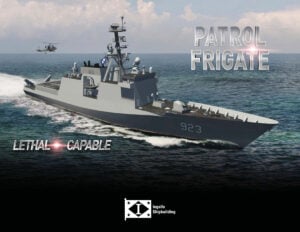
Three nuclear-powered supercarriers — Reagan, Roosevelt, and Nimitz — and their escorts exercise together in the Pacific.
WASHINGTON: President Trump has just issued orders to cut the defense budget, and hasn’t tweeted for a while about his campaign pledge to build a bigger Navy, but the top Republican on the Senate Armed Services Committee wants to get a 355-ship fleet back on the agenda. Jim Inhofe — who’s likely to retain the SASC chairmanship if the Republicans maintain their majority in the Senate in next week’s election — said he’s ready to hold hearings to keep the Navy’s feet to the flame.
The senator, who took over the committee after the death of John McCain, admitted during a radio interview Wednesday that the president’s plan to grow the fleet to 355 ships has “fallen behind a little bit,” but laid the blame on the Obama administration for underfunding the military. President Obama was “an in-the-heart liberal who really, you know where their priorities are, and it is not in defending America,” Inhofe told conservative radio host Hugh Hewitt.
Advocates and some Navy officials have said the 355-ship goal can be reached by the early 2030s if shipbuilders pick up the pace on new construction and the Navy extends the lives of its existing fleet well past their original design parameters: amphibious ships to more than 50 years, Littoral Combat Ships for up to 35 years, and Arleigh Burke-class destroyers to 45 years, for example. But other estimates — including from the No. 2 Trump appointee in the Navy Department — extend into the 2050s.
Inhofe didn’t make any promises about getting there quickly: “I think we can do it and that’s a long-range program,” he said, admitting that Congress hadn’t focused much attention on the issue because they “wanted to stop the bleeding in areas that had an immediate effect,” including building up readiness across all the armed services.
But Inhofe told Hewitt that after the midterm elections, he and Mississippi Republican Sen. Roger Wicker,, who chairs the seapower committee, will “put together a hearing specifically on that.”
Do Democrats Demur?
Any hearings on the Navy’s force size will likely have to compete with what promises to be a full slate of hearings on the House side, where Democrats are likely to regain power and are eager to start conducting oversight of the Pentagon and Washington’s years-long military actions in Syria, Iraq, Afghanistan, Somalia, Yemen, and other hot spots in Africa’s Sahel.
“The Trump White House, by and large, has let the Pentagon have a lot of free rein,” top House Armed Services Committee Democrat Adam Smith said last month. “I think that’s inappropriate, and I think there is a real role for Congress to step in where the White House has stepped back to make sure our military is not engaged in ways” that run contrary to American interests and values. If the Democrats take the House, Smith is expected to become chair of the House Armed Services Committee.
Adam Schiff, the Democratic ranking minority member of the House Intelligence Committee, expressed a similar view in a recent op-ed, writing Democrats “must do what the supine Republican Congress has failed to do over the past two years: restore Congress as an equal branch and check the ambition of an imperial and erratic president.”
But the shipbuilding issue will likely be one of the most complicated. The Trump White House recently ordered the Pentagon to shave $33 billion from its planned $733 billion fiscal 2020 defense budget, a last-minute change that surprised military leaders and leaves many big-ticket modernization programs in a precarious spot.

Huntington Ingalls concept for their Patrol Frigate, a militarized version of their Coast Guard National Security Cutter.
One program with some new question marks surrounding it is the Navy’s ambitious frigate program, which is slated to kick off in 2020. Back in February, the Navy picked five ship designs to compete to build 20 next-generation guided-missile frigates (FFG(X)) that will follow the Littoral Combat Ship. Austal USA, Lockheed Martin, General Dynamics Bath Iron Works, Fincantieri Marine and Huntington Ingalls Industries were each awarded $15 million contracts to refine their designs. Next comes the contract for actual production, with the Navy issuing a final Request For Proposal in 2019 and a contract award in 2020.
But it is still too early to tell which programs will be the bill payer for the last-minute change of heart by the White House, since the Pentagon is quickly building a new $700 billion budget, which ignores the impending return of the Budget Control Act, which would shave another $71 billion form the topline.
The Navy’s 2019 budget submission charted a course to grow to 326 ships by 2023. That leap of 46 ships from today’s count of 280 is something that Inhofe sounds very interested in keeping, but budget pressure, and skepticism from a changing House, might force a rewrite of those plans.
Pass a preemptive CR, deal with inflation and watch the debt limit: 3 tasks for Congress
John Ferrari and Elaine McCusker of AEI argue in this op-ed that Congress needs to act quickly to ensure American national security before getting bogged down in election season.




























